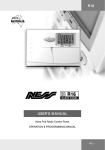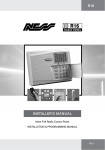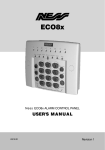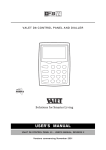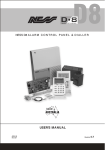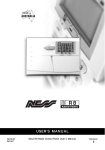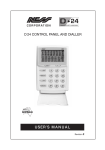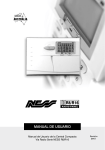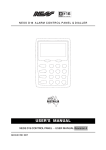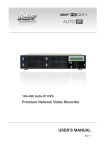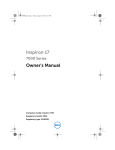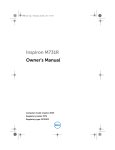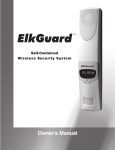Download uSer'S MANuAL r16 - Chubb Home Security
Transcript
R16 uSer’s MANUAL Ness R16 Radio Control Panel oPERATION & programming manual REV 1 Head Office: Ness Security Products Pty Ltd ABN 28 069 984 372 4 / 167 Prospect Hwy Seven Hills NSW 2147 Australia Ph +61 2 8825 9222 Admin Fax +61 2 9838 8508 [email protected] www.ness.com.au SYDNEY Ph 02 8825 9222 Fax 02 9674 2520 [email protected] MELBOURNE Ph 03 9875 6400 Fax 03 9875 6422 [email protected] BRISBANE Ph 07 3399 4910 Fax 07 3217 9711 [email protected] “Australia’s largest designer and manufacturer of high quality security products” PERTH Ph 08 9328 2511 Fax 08 9227 7073 [email protected] Adelaide Ph 08 8152 0000 Fax 08 8152 0100 [email protected] R16 User’s Manual Rev 1. March 2008 Document Part Number: 890-319 For products: 100-690 R16 Control Panel Approvals EMC COMPLIANCE EN 50130-4:1996 Part 4: Electromagnetic compatability. Electrostatic Discharge, Radiated RF Immunity, Electrical Fast Transient/burst. Surge Immunity, Conducted RF Immunity, Voltage Dips and Interruptions, Mains Supply Variations. AS/NZ CISPR 22:2002- Class B, Electromagnetic Radiation, Terminal Disturbance Voltage. EN61000-6-3:2001, Harmonic Current Emissions, Voltage fluctuations and Flicker. TELECOM TBR21, EU. PTC200, NEW ZEALAND TELECOM. AS ACIF S002, AUSTRALIA SAFETY EN60950:2000 inc Country Deviations, Safety of Information Technology Equipment AS/NZ3260-1993 incl. AMDTS 1,2,3 &4. TS001-1997 ACA Australian Communications Authority Copyright Notice All rights reserved. No part of this publication may be reproduced, transmitted or stored in a retrieval system in any form or by any means, electronic, mechanical, photocopying, recording, or otherwise, without the prior written permission of Ness. Ness reserves the right to make changes to features and specifications at any time without prior notification in the interest of ongoing product development and improvement. © 2008 Ness Security Products Pty Ltd ABN 28 069 984 372 CONTENTS Introduction .....................................................................................4 Compatibility....................................................................................5 R16 Keypad..................................................................................6, 7 Operation.........................................................................................8 Operation summary.........................................................................9 Arming............................................................................................10 Monitor Mode.................................................................................11 Disarming.......................................................................................12 Panic Alarm....................................................................................13 Duress Alarm..................................................................................14 Fire Alarm.......................................................................................15 Medical Alarm................................................................................15 Radio Doorbell...............................................................................16 Excluding Zones............................................................................17 View Memory...........................................................................18, 19 Monitoring Operation.....................................................................20 Remote Operation by Telephone . ................................................21 PROGRAMMING............................................................................22 Programming Options Table..........................................................23 Radio Doorbell...............................................................................24 Doorbell volume.............................................................................24 Doorbell tune.................................................................................25 Radio Key programming..........................................................26, 27 Keypad Code programming..........................................................28 Entry Delay programming..............................................................29 Exit Delay programming................................................................29 Specifications.................................................................................30 Installation Record.........................................................................31 Introduction The Ness R16 is a unique fully self-contained radio control panel. The built-in piezo siren provides high volume audible warning. The R16 also has Siren, Piezo and Strobe outputs for additional hardwired noisemakers. The panel has a built-in keypad for programming and user operation, a built-in piezo siren, builtin LCD display, built-in radio receiver, built-in battery backup and built-in dialler. The R16 has a number of sophisticated power saving features designed to provide at least 48 hours service running on the backup battery alone. (This includes one full alarm condition with sirens, strobe and dialler). The R16 supports up to 16 Ness Radio PIRs and up to 14 Ness Radio Keys. All Ness supervised and encrypted radio devices are supported. There is even a Doorbell feature with selectable tunes when used with the Ness Radio Doorbell transmitter. (If the radio doorbell is available in the local frequency). The built-in dialler uses Contact ID format for central station monitoring as well as audible monitoring to any telephone. The user can also dial into the system for remote arming and disarming over the telephone line. In addition to radio devices, the R16 has 1 hardwired zone and 1 hardwired tamper input for connection of a wired detection device and external siren cover tamper switch. RADIO DOOR SWITCHES RADIO KEYS RADIO DETECTION RADIO DOORBELL ARM 1 2 MONITOR 4 5 3 6 EXCLUDE 7 8 9 MEMORY P 0 E ZONE INPUT HARDWIRE EXTERNAL PLUGPACK (Supplied) PHONE LEAD (Supplied) SIREN OUTPUT STROBE OUTPUT TAMPER INPUT INTERNAL PIEZO OUTPUT Ness R16 Control panel - USER Manual Compatibility The Ness R16 supports all Ness radio devices as shown below. All late model Ness transmitters send encrypted transmissions to prevent eavesdropping and substitution. Ness fixed transmitters can send a regular supervision signal which the R16 monitors to ensure system security. 100-067 RK4 4 Button Radio Key 100-663 R15 Radio PIR 100-663PET R15PET 100-663 Radio PIR Pet Aware Radio PIR 100-664 RK3 3 Button Radio Key 100-691 R12 Radio PIR inc Bracket 100-683 RK1B 1 Button Radio Key Pendant 100-662 RR1 Radio Reed Switch 100-056 RDB Radio Doorbell 100-527 RR2 Multi-Purpose Radio Transmitter 100-283 RPB 1 Button Radio Panic Button 106-040 RSM Radio Smoke Detector RKP R A D I O K E Y PA D 100-001 RKP Radio Keypad 100-001 Radio Keypad Ness R16 Control panel - USER Manual R16 Keypad Audible & Visual feedback The R16 onboard keypad provides the facility for user level and installer level programming and all user operation and emergency functions. The keys are soft-touch silicon rubber and are backlit for high visibility. Any keypress will turn on the backlighting for 4 minutes. BACKLIT LCD DISPLAY ONBOARD SIREN / BEEPER OUTPUT ARM 1 2 3 MONITOR 4 5 6 EXCLUDE 7 8 9 MEMORY P 0 E FUNCTION BUTTONS OUTPUT TYPE PROGRAM ENTER DESCRIPTION SHORT BEEP Keypad Acknowledge key press 3 BEEPS (RAPID) Keypad Valid entry, end of Exit Time LONG BEEP Keypad Invalid entry 8 BEEPS (RAPID) Low battery / AC Fail / Medical Alarm CONTINUOUS BEEPS Alarm, Entry Delay, etc Onboard Siren External Siren output 1 CHIRP* Arm 3 CHIRPS* Disarm Onboard Siren DOORBELL TONES The Doorbell has been pressed. Onboard Siren External Siren output SIREN BURST, (Low Volume) Zone Auto Exclude warning Keypad beeper Onboard Siren Piezo output External Siren output SIREN CONTINUOUS Alarm condition Strobe output STROBE BURST Panel Armed or Disarmed STROBE CONTINUOUS Alarm condition * Arm/disarm chirps must be enabled by your installer. FIRE MEDICAL PANIC Ness R16 Control panel - USER Manual R16 Keypad Keypad Display in operating mode * The flashing RADIO fault icon could be indicating that the radio key/device has either low battery or supervision failure or other radio related problems. The numeric display 1–15 will show which device is sending the signal. See page 18: How to view memory. See page 19: The table Keypad Display in Memory Review Mode provides further detail. Ness R16 Control panel - USER Manual Operation Operating Modes Alarms, Definition The Ness R16 will operate in one of the following modes: Alarms may be caused by: Armed. The system is “On” and ready to detect intrusion. Disarmed. The system is “Off”. This is the normal mode when the premises are occupied. Day Zones and 24 Hour Zones such as external siren tamper, if used, are active. Day Mode. The system is Disarmed and a zone or zones have been setup to create an alarm when activated. Often used as a doorway alert in a shop. Monitor Mode. Allows the system to be “partially” Armed. For example, in a house, to allow all perimeter zones, doors and windows, to be Monitored (armed) at night. 24Hr Zones. Zones that have been setup to be active in any mode. Usually used for Tamper switches and Panic buttons. Doorbell. The doorbell can be triggered using the optional Ness Doorbell transmitter The doorbell function has adjustable volume and selectable chime settings. Operates in any panel mode. • A zone has been triggered while Armed • A Tamper has been triggered • A PANIC button has been triggered All of these may cause your sirens and strobe to operate. Various visual indications relevant to the alarm will be retained in the memory. If this occurs, Disarming your control panel will reset the alarm. The cause of the alarm can be identified by entering the Alarm Memory Mode as described on page 18. Resetting Alarms To stop the siren/s or to reset the strobe light if it is still flashing* (if installed), reset the panel using the keypad by entering a valid keypad code followed by the E button, or press the OFF button on a valid Radio Key. To check the cause of the alarm, you can view the event memory as shown on page 18. * In the event of an alarm, the strobe light will continue to flash until the panel is reset by the keypad or radio key, otherwise it will time out after 11 hours. (If mains power is disconnected, the panel will reset the strobe light output after 1 hour to conserve the backup battery). Ness R16 Control panel - USER Manual Operation Summary OPERATION ARM 1 2 MONITOR 4 5 6 EXCLUDE 7 8 9 MEMORY P 0 E DISARM To Disarm and/or reset alarms. RADIO KEY x1 Shortcut method, (If enabled by your installer). [User Code] Press the ON button once. x1 Press the OFF button once. [User Code] MONITOR MODE The panel must be in a Disarmed state first. KEYPAD [User Code] ARM The panel must be in a Disarmed state first. 3 x2 Shortcut method, (If enabled by your installer). Press ON button twice within 4 seconds. Radio Key Panic will function only if enabled by your installer. PANIC Both keys together Hold Keypad Panic must be enabled by your installer. KEYPAD DURESS Keypad Duress should only used by arrangement with your monitoring station. Radio Key Duress will function only if enabled by your installer. [User Code] To Disarm and report a Duress Alarm, add the digit 9 before your User Code when Disarming. This will function only if enabled by your installer. Hold EXCLUDING ZONES Zones can be Excluded when the panel is disarmed. ...then press [Zone No.] [Zone No.] ... Enter the zone numbers to be Excluded. To exit Exclude mode VIEW MEMORY View Memory can be used ...then press when the panel is disarmed. repeatedly to display the last 20 events. To exit Memory mode DOORBELL x1 RDB Radio Door Bell. (Depending on availability in the regional frequency). Note: Monitor Mode arming will be ignored if no monitor zones are programmed. Ness R16 Control panel - USER Manual Operation ARMING To Arm the system using the onboard keypad, press ARM followed by a valid user code, followed by the E key. [User Code] To Arm the system using a Radio Key press the ON button. x1 ...or The Arming Shortcut is enabled by default, this allows arming without having to enter your user code. (The Arming Shortcut can be disabled by your installer). If Siren Chirps have been enabled by your installer, the strobe light output will flash and the onboard siren will 'chirp' once to indicate successful arming. The control panel must be armed to enable detection zones. Note: If the panel is already in alarm, you must first silence the alarm before you can arm. Arming the panel starts the exit delay timer. All zones are inactive during this time and become fully armed once the exit delay time expires. (End of exit delay is signalled by 3 beeps from the keypad beeper). At the end of the exit time, all zones should be Sealed. If any are Unsealed, the onboard siren and the external siren, (if installed), will sound a lower volume tone for 2 seconds as a warning that those zones have been automatically excluded. For maximum security, you should return, disarm the panel, check the premises and then Arm again. Continual warnings could mean that a detector is faulty and may have to be manually excluded. The factory default exit delay time is 60 seconds. This can be changed if necessary, see the programming section in this manual. The panel must initially be in the disarmed state and not in Program, Monitor, Memory or Exclude modes. 10 If the auto-exclude option is disabled by your installer and a zone is unsealed at the end of exit time, the siren will sound for 5 minutes, (5 minutes is the factory default siren duration). Ness R16 Control panel - USER Manual Operation MONITOR MODE Ensure the system is disarmed before attempting to arm in Monitor Mode. [User Code] To arm in Monitor Mode using a Radio Key, press the ON button twice within 4 seconds. x2 ...or The Monitor Mode Shortcut is enabled by default, this allows arming of Monitor Mode without having to enter your user code. (Monitor Mode Shortcut can be disabled by your installer). Monitor mode allows you to Arm selected zones while others are ignored. Typically, perimeter zones (doors and windows) can be monitored while you are at home. If Siren Chirps have been enabled by your installer, the strobe light output will flash and the onboard siren will 'chirp' once to indicate successful arming in Monitor Mode. Entry and Exit delay timers operate as normal in Monitor Mode. Your installer must program which zones will be active in Monitor mode. If an alarm occurs while in Monitor mode, entering [User Code] will silence the alarm. This will also Disarm the panel, so remember to enter monitor again if needed. The panel must initially be in the disarmed state and not in Program, Monitor, Memory or Exclude modes. Using the optional Radio Keys you can enter Monitor Mode by pressing the ON button twice within 4 seconds. Ness R16 Control panel - USER Manual 11 Operation DISARMING To Disarm the system using the onboard keypad, enter a valid user code, followed by the E key. x1 [User Code] Sirens and strobe output, (if running), will be reset on disarming. When you enter the protected premises through a delay zone, the keypad will sound continuous beeps as a reminder to disarm. The panel must be disarmed before the entry delay time expires, otherwise the alarm will sound. If using a Radio Key, you can disarm from outside the premises without having to enter any protected zones. 12 To Disarm the system using a Radio Key press the OFF button. If Siren Chirps have been enabled by your installer, the strobe light output will flash and the onboard siren will 'chirp' three times to indicate successful disarming. The factory default entry delay time is 20 seconds. This can be changed if necessary, see the programming section in this manual. If you make a mistake in entering your code, press the E button and try again. Five incorrect code attempts will cause an alarm. Ness R16 Control panel - USER Manual Operation - Emergency functions PANIC ALARM To generate a Keypad PANIC alarm using the keypad, press both * (star) keys together for 2 seconds. To generate a PANIC alarm using a Radio Key, press the and hold the Radio Key PANIC button for at least 4 seconds. Hold Both keys together The Keypad Panic function is enabled by default, and can be disabled by your installer. The keypad panic function sounds the onboard siren and the external siren outputs. The sirens will reset when the Siren Reset Time has expired, (factory default is 5 minutes). A Panic report will be sent by dialler if your system is monitored by a Central Station. (If Panic reports have been enabled by your installer). The Radio Key Panic function will only function if enabled by your installer. Panic cannot be used while the panel is in Program, Memory or Exclude mode. Note: Your installer may have installed a separate panic button. To activate the panic alarm simply press that button. Ness R16 Control panel - USER Manual 13 Operation - Emergency functions DURESS ALARM To generate a DURESS alarm using the keypad, add the digit '9' in front of your code when disarming. 9 [User Code] The Keypad Duress function is disabled by default, and must be enabled by your installer. IMPORTANT NOTE: Your installer must program the R16 to enable Radio Key Panic to act as the DURESS alarm. This means Radio Key Panic will no longer be available. If enabled by your installer, to generate a DURESS alarm using a Radio Key, press and hold the Radio Key PANIC button for at least 4 seconds. Hold The DURESS alarm can be used to send a silent alarm to the Central Station that you are being forced to disarm the panel against your will. That is; you are disarming under “duress.” To Disarm and send a DURESS alarm, prefix your User Code with the digit 9 when Disarming. * DURESS Alarm is normally not enabled. To enable the DURESS function, consult your installer * DURESS alarms can only be used if your system is monitored by a Central Station. * The DURESS alarm does not sound any siren outputs and can only be reported by dialler to your central station. 14 Ness R16 Control panel - USER Manual Operation - Emergency functions FIRE ALARM To generate a FIRE alarm using the keypad, press and hold the FIRE key, (left hand star key), for at least 2 seconds. The FIRE Alarm cannot be generated by a Radio Key. Hold The Keypad Fire alarm function is disabled by default, and must be enabled by your installer. The FIRE alarm sounds the siren outputs using the Fire siren sound and the dialler reports a fire alarm. MEDICAL ALARM To generate a MEDICAL alarm using the keypad, press and hold the MEDICAL key, (right hand star key), for at least 2 seconds. Hold The Keypad Medical alarm function is disabled by default, and must be enabled by your installer. IMPORTANT NOTE: Your installer must program the R16 to enable Radio Key Panic to act as the MEDICAL alarm. This means Radio Key Panic will no longer be available. If enabled by your installer, to generate a MEDICAL alarm using a Radio Key, press and hold the Radio Key PANIC button for at least 4 seconds. Hold The primary purpose of this alarm is to report a MEDICAL alarm to your central station. The keypad beeper sounds 8 rapid beeps to indicate that the Medical alarm has been triggered. Ness R16 Control panel - USER Manual 15 Operation - Doorbell DOORBELL If a Ness Radio Doorbell has been installed, simply press the button once. Press Radio Doorbell transmitter. The doorbell tune is heard through the R16 onboard siren. The doorbell volume and the tune can be set by the user. IMPORTANT NOTE: The R16 can be programmed to allow Radio Key Panic to act as the DOORBELL. This means Radio Key Panic will no longer be available. If enabled by your installer, to sound the Doorbell, press and hold the Radio Key PANIC button for at least 4 seconds. Hold See pages 24 & 25 for doorbell volume and doorbell tune programming. If a Ness Radio Doorbell has been installed, simply press the button once. The R16 can also be programmed to operate the doorbell from the Panic button of Ness radio keys. Note that in this case, the R16 cannot receive Panic alarms from radio keys. 16 Ness R16 Control panel - USER Manual Operation - Excluding Zones EXCLUDING ZONES EXCLUDING ZONES To EXCLUDE zones, the R16 must be in the disarmed mode. [User Code] Press... or... The EXCLUDE icon will turn on. Enter the zone number of the zone/s to be excluded, (1-16). [Zone No.] [Zone No.] ...etc The zone light of each Excluded zone will turn on. Press... The to exit Exclude mode. EXCLUDE icon will flash continuously until the panel is next disarmed. If a detector becomes faulty and cannot be sealed when arming the panel, that zone can be Excluded so that it does not cause alarms. Zone Exclude is not permanent. Excluded zones are automatically Included next time the system is disarmed. When zones have been Excluded, the EXCLUDE icon flashes continuously while the panel is Disarmed and also when Armed. Zones can be manually included by the same method as Excluding. Simply use the Zones can only be excluded while the panel is disarmed. [ZONE NUMBER] sequence to turn OFF the zone icons to be Included. Ness R16 Control panel - USER Manual 17 Operation - View memory VIEWING MEMORY Press... [User Code] or... The MEMORY icon will turn on. Press... The most recent event will be displayed. Press... The next most recent event will be displayed. Press... Press... ...and so on (up to the last 20 events). to exit Memory mode. The R16 control panel stores a comprehensive event memory including Arming, Disarming, Low Battery, Mains Fail and Alarms. The memory is constantly upgraded and the last 20 events are always available for viewing. This memory display can only be selected while the panel is in the Disarmed state. 18 To Clear the Memory ICON The MEMORY icon on the LCD display flashes continuously when an alarm has occurred as a reminder to view the alarm memory. The MEMORY icon stops flashing after the memory is viewed as shown above. The MEMORY icon is automatically cleared next time the panel is Armed and on entry to program mode. Ness R16 Control panel - USER Manual Operation - View memory Keypad Display in Memory Review Mode Event Display Icons Arm ARMED Disarm blank Auto Exclude Zone EXCLUDE + 1...16 Mains Fail MAINS Panel Panic/Medical/Fire EXCLUDE Battery Fail BATTERY Line Fault LINE Dialler Call Fail LINE Zone Alarm 1...16 Tamper Panel/Siren TAMPER Tamper(4th failed attempts) TAMPER + PROGRAM Radio Jamming RADIO Radio Substitution RADIO Radio Key Low Battery RADIO + BATTERY + 2...15 Radio Key Panic/Medical RADIO + EXCLUDE Detector Tamper RADIO + TAMPER + 1...16 Detector Low Battery RADIO + BATTERY + 1...16 Detector Supervision Fail RADIO + 1...16 Pendant Supervision Fail RADIO + MONITOR + 1...15 Memory Review Examples Panel was Disarmed. Panel was Armed. Zone 3 alarm. Low Battery from radio device 1. Ness R16 Control panel - USER Manual 19 Monitoring CENTRAL STATION MONITORING Central Station Monitoring The R16 control panel has an on-board digital dialler which can send detailed alarm messages to a Central Monitoring Station. MONITORED PREMISES MONITORING STATION TELEPHONE LINE The digital messages can include information about the zone or zones which caused the alarm, tamper alarms, low battery or mains failure reports, and it can also (by user number) identify the users who Arm and Disarm the system. For further information about alarm monitoring, contact your dealer. AUDIBLE MONITORING MONITORED PREMISES TELEPHONE LINE ANY TELEPHONE Note: The R16 can be monitored by Central Station or by Voice Dialling to a private phone, but not by both simultaneously. Any telephone numbers programmed in options P70E & P71E must be erased to allow the Voice Dialling telephone numbers to work. (Ask your installer). 20 Ness Voice Dialling The dialler sends alarm reports to a private telephone, (mobile telephone or fixed telephone), using Voice Dialling Telephone numbers 1 and 2, (P00E, P01E). Enabling Voice Dialling Voice Dialling Format is enabled simply by programming the Voice Dialling phone number options P00E and P01E. (See side note. Central Station Monitoring must be disabled to enable Voice Dialling). Operation The word 'ALARM' is repeated for 30 seconds until the alarm is acknowledged (see below). If the alarm is not acknowledged the telephone number will be redialled. Ackowledging The Alarm The person receiving the call can acknowledge the alarm by pressing the # key on their telephone. Press the # key for 2 seconds during pauses in the audible message. (On mobile phones, press the # key in short bursts. Many mobile phones enter sub menus if the # key is pressed continuously). Ness R16 Control panel - USER Manual Remote Operation Audible Feedback Remote Telephone Arm/Disarm 3 BEEPS: Valid command/user code. The R16 can be armed and disarmed remotely using a standard fixed or mobile telephone. To maintain panel security, remote operations can only be activated after entering a valid user code. 1 LONG BEEP: Invalid command or user code, try again. To operate the R16 by telephone, you need a DTMF capable telephone, a valid User Code and you must know the Telephone number of the line to which the R16 is connected. Notes If the R16 does not receive remote commands for periods longer than 60 seconds it will assume that the call is finished and it will hang up. Remote Operation is disabled by default and must be enabled by your installer before it can be used. Sequence of Operation. 1. Phone the R16 telephone number and listen for the required number of double rings and then hang up. 2. Call the number again within 60 seconds. Summary of telephone commands 3. The R16 will answer the second call immediately, sound a beep for 2 seconds then, after a pause, it will sound a lower frequency tone. The R16 is now ready to receive telephone commands. Prepare to receive commands. 4. Press the button on the telephone. This tells the R16 that telephone commands will follow. [User Code] Verifies The user. Arm. Disarm. hang up. 5. Now enter a valid User Code followed by the button. The R16 will respond with 3 beeps if it recognises the code or 1 long beep to signal the code was invalid and to try again. 6. Enter the command to arm or disarm the panel. See: Summary Of Telephone Commands. 7. Press to finish. This tells the R16 to hang up. Also hang up your telephone. Ness R16 Control panel - USER Manual 21 Programming Various system options can be programmed by the user. These options can only be accessed from Program Mode. User Codes or Radio Keys can be added or deleted. Up to 15 keypad user codes or 14 Radio Keys or a mixture of both can be programmed. Entry and Exit timers can be changed if necessary, (between 1 and 99 seconds). To ENTER Program Mode [Master Code] To EXIT Program Mode The Doorbell Tune and Volume can be programmed. For all other programming changes, ask your installer. The panel will automatically exit Program Mode if no buttons are pressed for 4 minutes. 22 The factory default Master Code is: 123 Ness R16 Control panel - USER Manual Programming Programming Options Table OPTION NUMBERS RADIO CODES P10E DESCRIPTION DEFAULT P5E DOORBELL VOLUME Level 3 P6E DOORBELL TUNE Tune 3 P26E ENTRY DELAY TIME 20 seconds P28E EXIT DELAY TIME 60 seconds KEYPAD CODES P11E USER SLOT 1 MASTER KEYPAD CODE 2E P12E USER SLOT 2 3E P13E USER SLOT 3 4E P14E USER SLOT 4 5E P15E USER SLOT 5 6E P16E USER SLOT 6 7E P17E USER SLOT 7 8E P18E USER SLOT 8 9E P19E USER SLOT 9 10E P20E USER SLOT 10 11E P21E USER SLOT 11 12E P22E USER SLOT 12 13E P23E USER SLOT 13 14E P24E USER SLOT 14 15E P25E USER SLOT 15 123 User Slots 2 to 15 can store either a Keypad Code or a Radio Key, not both. If a user Slot is programmed as a Radio Key using option P10E, then that slot is not available as a Keypad Code and vice versa. Ness R16 Control panel - USER Manual 23 Programming - Doorbell TO PROGRAM A RADIO DOORBELL ACTION NOTE Program the Ness Radio Doorbell to an available User Slot. See page 26. "To Program Radio Keys" Program Extra Option 5E for that User Slot. See page 27. "Extra Options For Radio Codes" EXAMPLE: To program a Radio Doorbell to User Slot 15. In Program Mode: 1. Press... P10E 15E 2. Press and hold the Radio Doorbell button for 8 seconds. 3. Press... P25E 5E TO PROGRAM DOORBELL VOLUME ACTION NOTE [Master Code] Press... Enters Program Mode. The icon will turn on. P5E is the programming option number for Doorbell Volume. Press... The current doorbell tune will be played at the current volume level. The display will show a number between 1 & 4 to show the current volume level. (1=lowest, 4=highest). Factory default is 3. Press... (1 - 4) Each time you select a level the current doorbell tune will play once at that volume. Go to step 2 of any other programming option or press... 24 to exit program mode. E.g, Press 1E, 2E, 3E or 4E to select Lowest, Low, Medium or High volume. The icon . will turn off when you exit program mode. Ness R16 Control panel - USER Manual Programming - Doorbell See page 16 for Doorbell Operation. Ness R16 Control panel - USER Manual 25 Programming - Radio Keys The R16 will accept up to 14 Ness Radio Keys to be used for remote control wireless Arming/Disarming and Panic functions. Radio Keys are programmed to one of the 15 User Slots with the easy to use radio ‘Learn’ mode. A User Slot can hold either a keypad code or a radio key code, not both. User Code 1, (the master Code), is always a keypad code. TO PROGRAM RADIO KEYS ACTION Press... NOTE [Master Code] Enters Program Mode. The icon will turn on. P10E is the option number for programming Radio Keys. Press... Numbers 2 to 15 on the display will show which User Slots already contain Radio Keys, (if any). Press... (2 - 15) The chosen User Slot number will be flashing. User Slots with Radio keys already programmed will be on steady. Choose a User Slot to program a Radio Key. Enter a user slot number from 2 to 15 followed by the E button. Press and hold the PANIC button for at least 8 seconds on the Radio Key to be programmed. This transmits the 'Learn' message to the R16 panel. If the Radio Key was successfully programmed, you will hear beep, beep + 3 beeps. A long beep means the Radio Key is already programmed to another User Slot. See Extra Options For Radio Codes on the next page to program the behaviour of the Radio Key's Panic button. Or skip to step 6 to leave the factory default. (Panic button triggers Panic Alarm). Go to step 2 of any other programming option or press... to exit program mode. The icon . will turn off when you exit program mode. TO DELETE RADIO KEYS To delete a Radio Key, press P10E, select the User Slot to delete (2E-15E), then press P10E again. The panel must be in Program Mode. EXAMPLE: To delete the Radio key programmed on User Slot 2. Press... P10E 2E P10E 26 Ness R16 Control panel - USER Manual Programming - Radio Keys How to send the Learn Message - Portable Transmitters This table shows the method for sending the programming ‘Learn’ message for compatible Ness transmitters. RKP R A D I O K E Y PA D RK4 Radio Key Press and hold Panic for 8 seconds. RDB Radio DoorBell Press and hold for 8 seconds. RK1B Radio Panic Press 3 times. RKP Radio Keypad Insert the battery or consult the Radio Keypad manual. 100-001 Radio Keypad Extra Options For Radio Codes Each User Slot has five Extra Options which control the behaviour of Radio Keys and the Radio Doorbell transmitter. The Extra Options are: 1E, Panic: The Panic Button will trigger the Panic alarm. (default). 2E, Duress: The Panic Button will trigger the Duress alarm. 3E, Medical: The Panic Button will trigger the Medical alarm. 4E, Ignore Panic: Disables Panic Button on radio keys. 5E, Doorbell: The Panic Button will sound the R16 doorbell feature.* Each User Slot is defaulted for Extra Option 1E, trigger Panic. The Extra option for a user code slot can be programmed after a radio key has been programmed to that slot. Programming sequence For Extra Options 1. Press: P [User Slot option number 12-25] E • If a Radio Key is programmed to the User Slot, the RADIO icon will be on. Icons 1–5 show which Extra Option is currently selected. 2. Press: [1–5] E • This selects a new Extra Option. EXAMPLE When programming a Radio Doorbell*, the User Slot must be set for ‘Doorbell’ or the Panic alarm will be triggered when the doorbell is pressed. In this example, a Radio Doorbell has been programmed to User Slot 15. To program the Extra Option for User Slot 15, in program mode, press: P25E 5E Ness R16 Control panel - USER Manual 27 Programming - Keypad Codes 1 2 3 4 5 6 7 8 9 P 0 E TO PROGRAM KEYPAD CODES ACTION NOTE Press... [Master Code] Press... [11-25] Enters Program Mode. The The existing code will be displayed one digit at a time. Enter the option number for the Keypad Code you are programming. Press... (NEW CODE) icon will turn on. You will hear one beep on the first entry of the new code and three beeps when the code is verified. (NEW CODE) Enter the new code twice for verification. EXAMPLE: To program Keypad Code 2 to be 1234: The new code will be displayed one digit at a time. Press... P12E 1234E 1234E Go to step 2 of any other programming option to exit program mode. or press... The icon . will turn off when you exit program mode. TO DELETE KEYPAD CODES To delete a Keypad Code, enter the MEMORY button in place of the code. The panel must be in Program Mode. EXAMPLE: To delete the Keypad Code 2: Press... P12E MEMORY E Notes on Programming Keypad Codes • Keypad Codes can be 3 to 6 digits in length. • Codes beginning with 0 (zero) can be programmed but they will not operate the panel - this is an alternative method for disabling user codes. The MEMORY E function is the recommended method of deleting user codes. • All codes must be unique to each other. Codes are rejected if already used. Some codes that are similar to existing codes may also be rejected. 28 • User Code 1 (Master Code) can be changed but it can not be deleted. The MEMORY + E sequence simply reverts User Code 1 back to factory default of 123. • Open/Close reports, (if enabled by your installer), are identified by user number if the control panel is central station monitored. Shortcut arming, (ARM + E, (if enabled), is identified to the central station as User 25. Ness R16 Control panel - USER Manual Programming - Timers TO PROGRAM ENTRY DELAY TIME ACTION NOTE [Master Code] Press... Press... P26E is the option number for Entry Delay Time. Press... (NEW TIME) Enter a new entry delay time from 1 to 99 seconds. Enters Program Mode. The icon will turn on. The existing time will be displayed one digit at a time. The factory default time is 20 seconds. The new time will be displayed one digit at a time. EXAMPLE: To make the entry delay time 25 seconds: Press... P26E 25E Go to step 2 of any other programming option to exit program mode. or press... The icon . will turn off when you exit program mode. TO PROGRAM EXIT DELAY TIME ACTION NOTE See step 1 of Entry Delay programming, or if already in program mode, continue to step 2. Press... P28E is the option number for Exit Delay Time. Press... (NEW TIME) Enter a new exit delay time from 1 to 99 seconds. When in Program Mode. The icon is on. The existing time will be displayed one digit at a time. The factory default time is 60 seconds. The new time will be displayed one digit at a time. EXAMPLE: To make the exit delay time 50 seconds: Press... P28E 50E Go to step 2 of any other programming option or press... to exit program mode. The icon . will turn off when you exit program mode. Ness R16 Control panel - USER Manual 29 Specifications Radio zones 16 Hardwired zones 1 (operates in series with zone 16) Hardwired tamper zones 1 Radio compatibility Ness supervised & encrypted radio devices Dialler format Contact ID Format Audible Voice Format On board Keypad Backlit, programming & user functions LCD display High contrast icon display Plug pack 220-240V AC 50-60Hz, output 17V AC @300mA Quiescent current draw 10 mA (in power save mode if mains is off) Built-in backup battery 12 volt 0.8 Amp/hour, sealed lead acid Dynamic Battery Test Every Hour and on arming/disarming Fuses Siren Output, 2A Auto-reset Strobe, 1.5A Auto-reset Piez Output, 500mA Auto-reset Built-in Piezo, 500mA Auto-reset Siren output 1 x 8 Ohm horn speaker max. On board piezo siren 110 dB PIEZ (Reset) output 12V DC 300mA max. Strobe output 12V DC, 1 strobe light max. Dimensions 210(w) x 145(h) x 40(d) mm 30 Ness R16 Control panel - USER Manual Installation Record Date Installed: Doorbell Volume Installation Company: Doorbell Tune Telephone: Monitoring Company: Telephone: Zone Description Zone 1 9 2 10 3 11 4 12 5 13 6 14 7 15 8 16 User Slot User Code 1 (Master Code) User Code 2 User Code 3 User Code 4 User Code 5 User Code 6 User Code 7 User Code 8 User Code 9 User Code 10 User Code 11 User Code 12 User Code 13 User Code 14 User Code 15 User's Name Entry Delay Time Seconds Exit Delay Time Seconds Description user Type Keypad Radio CODE YES Ness Limited Warranty: Ness Security Products Pty Ltd warrants its products to be free from manufacturing defects in materials or workmanship for the warranty period as detailed in Ness’ Terms and Conditions of Sale and all other obligations detailed in those Terms and Conditions. Whilst Ness Security Products, the manufacturer, is accredited to ISO9001 and all possible care and diligence has been applied during manufacture to ensure the reliable operation of this unit, there are various external factors that MAY impede or restrict the operation of this unit in accordance with the product's specification. These factors include, but are not limited to, 1. Failure to communicate to the monitoring company due to a telephone service provider’s line fault or due to the incorrect configuration of the telephone/Product to the Telephone Network. It is the responsibility of a qualified Installer to ensure correct configuration to the telephone network. 2. Erratic or reduced radio range as detailed in the manufacturer’s specifications. Ness’ radio based products are sophisticated low power devices however the presence of in-band radio signals, high power transmissions or interference caused by electrical appliances e.g. computers, televisions etc. MAY reduce the range performance. Whilst such occurrences are unusual, they are possible none the less. If a problem such as this is encountered and the performance is unsatisfactory, the installer of the product should be contacted immediately. 3. Unauthorised tampering, physical damage, electrical interruptions such as mains failure, electrical spikes or lightning. Ness Security Products is not an insurer of either property or safety of the user and limits its liability for any loss or damage including incidental or consequential damages to Ness' original selling price. There are no warranties, expressed or implied, which extend beyond the description on the face hereof. Ness Security Products recommend that the system is tested weekly to confirm reliable operation.
































